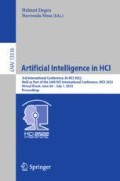Abstract
Artificial intelligence (AI) technologies have been extensively used in education to improve the learning experience of students. We are particularly interested in AI in education for children and teens. This systematic review summarizes the state of the literature by exploring how AI technologies have been adopted and perceived by children and teens in education. Based on the PRISMA review framework [17], we performed three rounds of systematic selection in three databases: Education Source, ERIC (Educational Resources Information Center), and ACM Digital Library. The final sample includes 5 articles. The AI technologies involved in these studies include social robots, conversational agents, and AI-based educational games. It is noted that three of the studies focused on AI robots and related technologies. The analysis of these articles showed that it is important to study the use and perception of AI technologies by children and teens in education, and there is a research gap that must be addressed in this field.
Access this chapter
Tax calculation will be finalised at checkout
Purchases are for personal use only
References
Chen, L., Chen, P., Lin, Z.: Artificial intelligence in education: a review. IEEE Access 8, 75264–75278 (2020)
Druga, S.: Cognimate (2018)
Druga, S., Williams, R., Breazeal, C., Resnick, M.: Hey google is it ok if I eat you?: Initial explorations in childagent interaction. In: Proceedings of the 2017 Conference on Interaction Design and Children, pp. 595–600 (2017)
Druga, S., Williams, R., Park, H.W., Breazeal, C.: How smart are the smart toys?: children and parents’ agent interaction and intelligence attribution. In: Proceedings of the 17th ACM Conference on Interaction Design and Children, pp. 231–240 (2018)
Holmes, W., Bialik, M., Fadel, C.: Artificial Intelligence in Education, pp. 1–35. Center for Curriculum Redesign, Boston (2019)
Kahn, K.M., Winters, N.: AI programming by children (2018). https://project.ecraft2learn.eu/wp-content/uploads/2018/08/Ai_programming_Constructionism_2018-v2.pdf
Kewalramani, S., Kidman, G., Palaiologou, I.: Using Artificial Intelligence (AI)-interfaced robotic toys in early childhood settings: a case for children’s inquiry literacy. Eur. Early Child. Educ. Res. J. 29(5), 652–668 (2021)
Landing AI: Landing A.I. Creates an AI Tool to Help Customers Monitor Social Distancing in the Workplace (2020). https://landing.ai/landing-ai-creates-an-ai-tool-to-help-customers-monitor-social-distancing-in-the-workplace/
Lane, D.: Machine learning for kids (2018)
Lin, P., Van Brummelen, J., Lukin, G., Williams, R., Breazeal, C.: Zhorai: designing a conversational agent for children to explore machine learning concepts. In: Proceedings of the AAAI Conference on Artificial Intelligence, vol. 34, no. 09, pp. 13381–13388 (2020)
Medical Device Network: What are the main types of robots used in healthcare? (2020). https://www.medicaldevice-network.com/comment/what-are-the-main-types-of-robots-used-in-healthcare/
McReynolds, E., Hubbard, S., Lau, T., Saraf, A., Cakmak, M., Roesner, F.: Toys that listen: a study of parents, children, and internet-connected toys. In: Proceedings of the 2017 CHI Conference on Human Factors in Computing Systems, pp. 5197–5207 (2017)
NITRD: The National Artificial Intelligence Research and Development Strategic Plan: 2019 Update (nitrd.gov) (2019)
Ouherrou, N., Elhammoumi, O., Benmarrakchi, F., El Kafi, J.: Comparative study on emotions analysis from facial expressions in children with and without learning disabilities in virtual learning environment. Educ. Inf. Technol. 24(2), 1777–1792 (2019). https://doi.org/10.1007/s10639-018-09852-5
Papert, S., Solomon, C.: Twenty things to do with a computer, Cambridge, MA (1971)
Pearson: ‘Pearson hires new head of artificial intelligence’. Press release, July 2018. https://plc.pearson.com/en-US/news/pearson-hires-new-head-artificial-intelligence
PRISMA Review. PRISMA (prisma-statement.org)
Porayska-Pomsta, K., et al.: Blending human and artificial intelligence to support autistic children’s social communication skills. ACM Trans. Comput.-Hum. Interact. (TOCHI) 25(6), 1–35 (2018)
Pueyo, V., et al.: Development of a system based on artificial intelligence to identify visual problems in children: study protocol of the TrackAI project. BMJ Open 10(2), e033139 (2020)
Sabuncuoglu, A.: Designing one year curriculum to teach artificial intelligence for middle school. In: Proceedings of the 2020 ACM Conference on Innovation and Technology in Computer Science Education, pp. 96–102 (2020)
Severson, R.L., Carlson, S.M.: Behaving as or behaving as if? Childrens conceptions of personified robots and the emergence of a new ontological category. Neural Netw. 23(8–9), 1099–1103 (2010)
Timms, M.J.: Letting artificial intelligence in education out of the box: educational cobots and smart classrooms. Int. J. Artif. Intell. Educ. 26(2), 701–712 (2016)
Toivonen, T., Jormanainen, I., Kahila, J., Tedre, M., Valtonen, T., Vartiainen, H.: Co-designing machine learning apps in K-12 with primary school children. In: 2020 IEEE 20th International Conference on Advanced Learning Technologies (ICALT), pp. 308–310. IEEE (2020)
Van Brummelen, J., Tabunshchyk, V., Heng, T.: “Alexa, can I program you?”: student perceptions of conversational artificial intelligence before and after programming Alexa. In: Interaction Design and Children, pp. 305–313 (2021)
Voulgari, I., Zammit, M., Stouraitis, E., Liapis, A., Yannakakis, G.: Learn to machine learn: designing a game based approach for teaching machine learning to primary and secondary education students. In: Interaction Design and Children, pp. 593–598 (2021)
Weng, T.S., Li, C.K., Hsu, M.H.: Development of robotic quiz games for self-regulated learning of primary school children. In: 2020 3rd Artificial Intelligence and Cloud Computing Conference, pp. 58–62 (2020)
Williams, R., Park, H.W., Breazeal, C.: A is for artificial intelligence: the impact of artificial intelligence activities on young children’s perceptions of robots. In: Proceedings of the 2019 CHI Conference on Human Factors in Computing Systems, pp. 1–11 (2019)
Williams, R., Park, H.W., Oh, L., Breazeal, C.: PopBots: designing an artificial intelligence curriculum for early childhood education. In: Proceedings of the AAAI Conference on Artificial Intelligence, vol. 33, no. 1, pp. 9729–9736 (2019)
Acknowledgements
We thank all the reviewers for their constructive comments.
Author information
Authors and Affiliations
Corresponding author
Editor information
Editors and Affiliations
Rights and permissions
Copyright information
© 2022 The Author(s), under exclusive license to Springer Nature Switzerland AG
About this paper
Cite this paper
Li, E., Li, S., Yuan, X. (2022). Adoption and Perception of Artificial Intelligence Technologies by Children and Teens in Education. In: Degen, H., Ntoa, S. (eds) Artificial Intelligence in HCI. HCII 2022. Lecture Notes in Computer Science(), vol 13336. Springer, Cham. https://doi.org/10.1007/978-3-031-05643-7_5
Download citation
DOI: https://doi.org/10.1007/978-3-031-05643-7_5
Published:
Publisher Name: Springer, Cham
Print ISBN: 978-3-031-05642-0
Online ISBN: 978-3-031-05643-7
eBook Packages: Computer ScienceComputer Science (R0)

